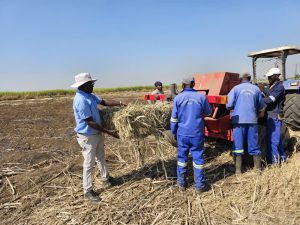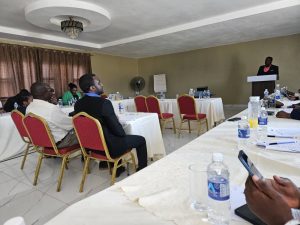Patrice Talla
This year we are celebrating the International Year of Millets. The year was endorsed by Members of the Food and Agriculture Organization of the United Nations (FAO) and its Governing Bodies and declared at the 75th Session of the UN General Assembly (UNGA) in March 2021. FAO is the Agency taking the lead in celebrating this year.
The focus on Millets could not be timelier. They offer valuable solutions in the face of climate change and the need for nutritious foods. They are climate resilient, nutrition rich, resistant to pests and diseases, and have the ability to grow on arid lands. Millets are, therefore, an ideal solution for countries to increase food security or food self-sufficiency with the potential for everyone to attain better production, better nutrition, a better environment, and a better life.
As such, the International Year of Millets is a global opportunity for us to direct policy attention to the nutritional and health benefits of millets and their suitability for cultivation under adverse and changing climatic conditions, and to deepen our determination to accelerate progress on the Sustainable Development Goals. The International Treaty on Plant Genetic Resources for Food and Agriculture of the FAO and, in particularly, the International Treaty’s Benefit-sharing Fund (BSF) supports agricultural programs in developing countries, including those supporting the diversification of food crops in the face of changing climate, growing populations and the need for nutrition. That includes the (re-) introduction of traditional crops, such as millets, which have valuable benefits for all.
The International Treaty works with farmers and policy-makers around the world to take care of the seeds and other plant material that form the basis of our food from plants. Through its Benefit-sharing Fund (BSF), the International Treaty supports vulnerable and marginalized farming communities in developing countries to conserve and sustainably use crop diversity, to ensure food security and adaptation in the face of climate change. It contributes to farmers safeguarding millets and other crops around the world. It also calls on nations to protect and promote Farmers’ Rights, and is the first legally-binding international instrument to do so and to explicitly acknowledge the enormous contribution of indigenous communities and smallholder farmers toward the plants that feed the world.
The International Treaty’s BSF provides a bridge between all actors in the agricultural diversity food chain. It brings together farmers, plant breeders, civil society, research institutions and other stakeholders to solve local and global agricultural challenges. To date, the BSF has supported 80 projects in 67 developing countries around the world, including Malawi, Zambia and Zimbabwe. The BSF functions with major contributions from the European Union, Italy and Norway, among others.
In Zimbabwe, the BSF has made significant contributions to household food security and resilience. In marginal and low rainfall regions of Zimbabwe, women farmers are now increasingly relying on millets (such as finger millet, pearl millet and sorghum) to ensure food and nutrition security for their families and for income generation. Within the semi-arid environments of Zimbabwe, millets are becoming the new “maize,” because of their abilities to adapt to climate change induced droughts. Community Seed Banks supported by the International Treaty’s BSF have greatly contributed to reduced production costs, providing timely easy access to local seed varieties.
Future of food and nutrition security lies in participatory seed breeding
In Zimbabwe, women in Farmer Field Schools (FFS) have played a major role in introducing new millet varieties through Participatory Variety Selection (PVS) as well as enhancing popular millet and sorghum varieties through Participatory Variety Enhancement activities. Results of some of these PVS demonstration plots contributed to the release of two sorghum varieties being evaluated in 141 demonstration plots in Malawi, Zambia and Zimbabwe under a BSF project.
Women famers in Zimbabwe have also gone out of their way to ensure that the local market of traditional grains is strong. Farmer groups, working within their FFS, have gone into seed production of sorghums and millets, seed exchange through seed and food fairs at community levels where they exchange seeds of these cereals, knowledge and recipes.
Policy attention on millets critical to ensure that everyone is food secure
Policy advocacy meetings on Farmers’ Rights conducted in Malawi, Zambia and Zimbabwe, have contributed to discussions and development of the Seed Bill in Malawi and the development of the National Strategy and Action Plan on Plant Genetic Resources for Food and Agriculture (NSAP on PGRFA) in Zimbabwe; however, more policy interventions are needed to ensure that everyone is food secure.
The success of the National Strategic Action Plan in Zimbabwe depends on deliberate actions to restore millets at the center of production, enhance the preference of millet based diets, increased consumption and utility. We encourage Zimbabwe and Southern Africa to take deliberate actions to conserve, protect, restore, sustainably manage and use millet biodiversity.
Millets offer opportunities for strengthening food security and bolstering economic growth. That means we need to ensure millets are integrated into mainstream agriculture, diets, industries and health for all.
Achieving Zero Hunger requires collective action
To achieve the full potential of millets requires us all to take collective action. Everyone has a role to play – from governments and private sector companies to the general public and even youth. We need to work together to unleash the potential of millets for human well-being, food systems, poverty alleviation and the adaptation of agriculture to climate change.
We must address the global decline of the production of millets and a diverse food basket, as humanity has become too reliant on a narrow selection of crops and species. We must foster collaboration across funding partners, governments, civil society, private sector, and the technical community to ensure the benefits of millets are equally distributed.
Non-governmental organizations (NGOs), cooperatives and civil society working directly with farmers need to share best practices for cultivating millets and provide farmers with practical support, training and ways to better connect to the market. Civil society and NGOs should form networks and action groups to promote the availability, accessibility and affordability of millets.
Researchers and academic institutions should dedicate resources to researching millets, their nutritional values, properties and characteristics, as well as appropriate mechanization and other methodologies that can make millet cultivation more sustainable.
FAO fully supports the government of Zimbabwe’s sustained promotion of small grains through input support programmes such as Pfumvudza, and encourages relevant value chain players in the food and agriculture sectors to complement the government efforts to consider millets as a strategic crop.
Patrice Talla is FAO Subregional Coordinator for Southern Africa and FAO Representative in Zimbabwe, Eswatini and Lesotho.






